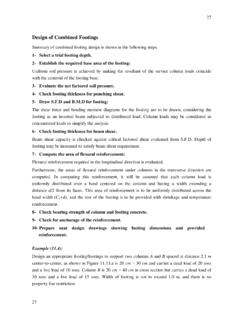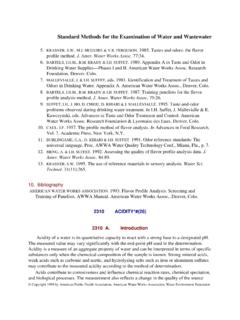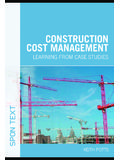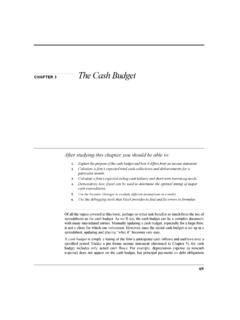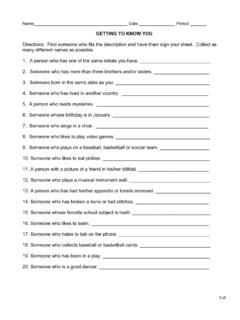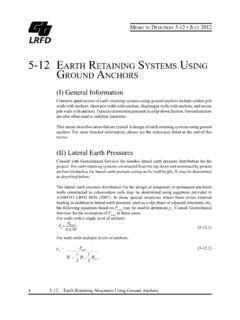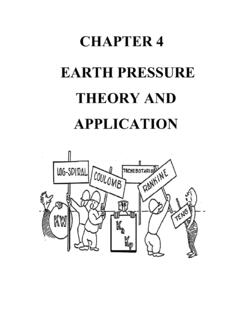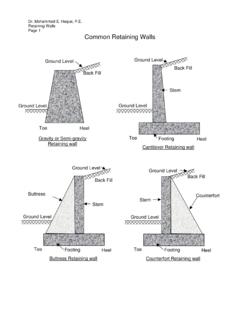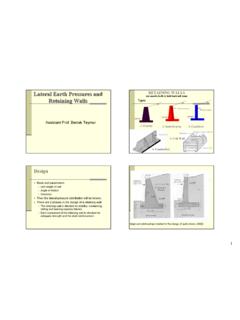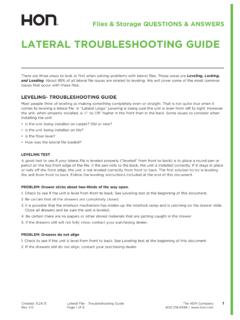Transcription of Chapter (7) Lateral Earth Pressure - Islamic University of Gaza
1 Chapter (7) Lateral Earth Pressure Page (158) Ahmed S. Al-Agha Foundation Engineering Lateral Earth Pressure Introduction Vertical or near vertical slopes of soil are supported by retaining walls, cantilever sheet-pile walls, sheet-pile bulkheads, braced cuts, and other similar structures. The proper design of those structures required estimation of Lateral Earth Pressure , which is a function of several factors, such as (a) type and amount of wall movement, (b) shear strength parameters of the soil, (c) unit weight of the soil, and (d) drainage conditions in the backfill.
2 The following figures shows a retaining wall of height H. For similar types of backfill. Page (159) Ahmed S. Al-Agha Foundation Engineering Lateral Earth Pressure As shown in figure above, there are three types of Lateral Earth Pressure (LEP): 1. At Rest Lateral Earth Pressure : The wall may be restrained from moving, for example; basement wall is restrained to move due to slab of the basement and the Lateral Earth force in this case can be termed as" P ".
3 2. Active Lateral Earth Pressure : In case of the wall is free from its upper edge (retaining wall), the wall may move away from the soil that is retained with distance "+ H " ( the soil pushes the wall away) this means the soil is active and the force of this pushing is called active force and termed by " P ". 3. Passive Lateral Earth Pressure : For the wall shown above (retaining wall) in the left side there exist a soil with height less than the soil in the right and as mentioned above the right soil will pushes the wall away, so the wall will be pushed into the left soil ( soil compresses the left soil) this means the soil has a passive effect and the force in this case is called passive force and termed by " P ".
4 Now, we want to calculate the Lateral Pressure from water firstly and from Earth (3 cases mentioned above) secondly. Lateral Pressure from Water As we learned previously in fluid mechanics course, the Pressure of static fluid at a specific point is the same in all directions Pascal s Law . So if there exist water in the soil (saturated soil) we must calculate the vertical stress for soil alone (effective stress) and calculate the vertical Pressure for water alone (because the horizontal Pressure of water is the same as vertical Pressure ), but for soil, each one according soil parameters- having different transformation factor from vertical to horizontal Pressure as we will discuss later.
5 The following figure showing that the horizontal Pressure of water against a wall is the same as vertical Pressure : Page (160) Ahmed S. Al-Agha Foundation Engineering Lateral Earth Pressure At Rest Lateral Earth Pressure : As stated above, the soil in this case is static and can t pushes the wall with any movement, the transformation factor of vertical Pressure to horizontal Pressure in this case is "K " and the Lateral Earth force is termed by "P " Calculation of at rest Lateral Earth force " " for different cases: Firstly the value of K can be calculated as following.
6 K =1 sin Always, (at rest) Lateral Earth Pressure at any depth (z) may be calculated as following: , =vertical effective Pressure ( ) K +Pore water Pressure (u) =q+ z , u= z , = K +u Note that the value of (u) doesn t multiplied by any factor since the horizontal Pressure of water is the same as vertical Pressure . Page (161) Ahmed S. Al-Agha Foundation Engineering Lateral Earth Pressure As shown there is no water table.
7 Firstly we calculate the vertical stress at each depth (each change): At depth z= : =q At depth z=H: =q+ H So, Lateral at rest Pressure at each depth now can be calculated: At depth z= : , =qK At depth z=H: , =(q+ H) K Now calculate the Lateral forces P and P and then calculate P : P =Area of rectangle (1)=qK H (per unit lenght) P =Area of triangle (2)=12 ( H K ) H=12 H K P =P +P To find the location of P , take summation moments at point A (for ex.): P H2+P H3=P z z =.
8 QK (q+ H)K P P P z , Page (162) Ahmed S. Al-Agha Foundation Engineering Lateral Earth Pressure In case of water table (if exist): Firstly we calculate the vertical stress at each depth (each change): At depth z= : =q At depth z=H : =q+ H u= At depth z=H : =q+ H + H ( = ) u= H Now calculate the Lateral forces P ,P ,P ,P and P then calculate P.
9 P =area of recangle(1)=qK H P =area of triangle(2)=12 H K P =area of recangle(3)=(q+ H )K H P =area of triangle(4)=12 H K P =area of triangle(5)=12 H (factor for water=1) P =P +P +P +P +P To find the location of P , take summation moments at point A (for ex.): ( ,P must be included in moment equation) (See example Page 327) qK (q+ H )K (q+ H + H )K H , Page (163) Ahmed S.
10 Al-Agha Foundation Engineering Lateral Earth Pressure Lateral Earth PressureTheories Two theories are used to calculate Lateral Earth Pressure (active and passive): Rankine Earth Pressure theory and Coulomb s Earth Pressure theory. Firstly we will learn rankine Earth Pressure theory (the most important) and then coulomb Earth Pressure theory. Rankine Active Lateral Earth Pressure This theory is based mainly on the assumption of neglecting friction between the soil and the wall, so no shear forces are developed on soil particles.
